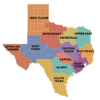By Ed Curtis, CEO, YTexas
June 1, 2022
Over the past 5 years, YTexas has grown its presence in Houston. In that time, I’ve had the opportunity to meet some of the movers and shakers who have experienced the ups and downs of the Houston economy. Al Hartman, the CEO of Hartman Income REIT, is one of those. He has his finger on the pulse of the Houston commercial real estate market. Here’s what he had to say about the state of the market in Houston:
EC:
Al, it’s great to have this opportunity to speak with you.
Before we get started, I’d love to learn how you got into the commercial real estate industry in Texas?
AH:
Well Ed, it’s interesting. I was living in Indiana. I was around 27 years old and was making quite a bit of money selling home improvement services door to door. I wanted to find a way to shelter my income, so I read some books about how to make money in real estate. Soon after, I started buying commercial and residential real estate in Indiana. I bought four different properties, about 30 units all together, and owned those for a couple of years.
I wanted to buy more, so I started researching cities in other states, mainly Florida, Arizona and Texas. However, I saw what was happening in Houston and started investing there. This was in the 80’s when Houston was known as the Golden buckle on the Sunbelt. It was growing faster than nearly anywhere else in the country because of the oil boom at the time. So, I sold all my properties in Indiana, moved to Houston and started buying properties here.
Shortly after I moved here, the oil bubble burst and oil at one point fell as low as $9 a barrel. So, in 1983 when I bought my first property, the market was declining. However, while I had high leverage on my properties, I was able to keep them leased up and cash flowing. I got through a difficult time. It was so bad, worse than the Great Depression. Everything was overbuilt with 30% vacancy rates in office buildings. As time went on, I was able to gradually lower my leverage by paying down the debt I had on the properties. I bought more properties over the next 10 years. Houston hit bottom and took about another 10 years to get through the whole cycle. During that period of time, I bought 20 properties in a row. They were all foreclosures. Despite the downturns, I believed that Houston would flourish once again.
EC
What did you learn from this – and how are things now?
AH:
First, keep leverage low. We have below 50% leverage on our properties. We’re very intentional about keeping our debt low. Second, we focus on value added leasing. It’s what I did with residential early on. I would buy properties that needed attention and turned them around. We have become very adept at buying properties that have some form of distress and low occupancy of 50, 60 to 70%. When you buy like that, you can create a lot of value for investors. In fact, we have a phenomenal track record and have been recognized as the number one non-traded REIT by Stanger, an independent publication, over a 5 year period as recently as 2021.
We evaluate a lot of potential properties, and I learned that early on. You have to look at enough properties to get the right one. We look at around 600 properties per year and deeply review about 100 to buy one. Then, after we buy it, we put our team on it to turn it around and begin leasing. We have an amazing staff who just do an excellent, excellent job. In fact, our vertically integrated firm is what gives us our strong competitive edge compared to other REITS. From property management, to leasing, marketing, and engineering, we do it all in house.
We bought nine properties in 2019, some of which, in spite of COVID, have gone from 50% leased to 90% and some are now at 100%. It’s pretty incredible what we were able to do. 2020 was not such a good year due to COVID. We lost occupancy in our portfolio. But in 2021, we recovered very handsomely. While other landlords were struggling, we increased our occupancy by 4% in the portfolio and signed almost a million square feet with 600 leases in one year, which is a record for us. We did this by tapping into the capabilities of our vertically integrated firm. Our construction team worked days, nights, and weekends to have a selection of move-in-ready spaces at every property to allow quick move-ins for new tenants. Additionally, we hired a moving coordinator to help all new tenants have a smooth transition from their old office or work from home setup.
EC:
How difficult is it to find properties now?
AH:
I am not seeing many opportunities in Dallas or San Antonio and certainly in Austin, that market is overheating. However, in Houston we’re seeing opportunities that we haven’t seen in a decade. We are seeing some very good buys. The yields on some of these properties are as high as 15% return on cost on an unleveraged basis that after are stabilized. Our normal model is 10% performance yield at stabilization. Over the years, we stayed at 10% once the property stabilized (generally, 90% occupancy and higher). Now, we’re seeing yields north of 12-14% performance overall yields. There are great opportunities out there for what we do!
EC:
How do you see interest rates playing into your investment strategy? Will rates continue to increase?
AH:
Well, that’s a very timely question because we’re right in the middle of refinancing our whole portfolio. We’ve ridden interest rates down and have been floating for the better part of 30 years. They hit bottom about a year ago. I believe that they are going to keep moving up as long as inflation continues. We are in the process of refinancing, locking everything in for 10 years and will close these transactions over the next couple of months.
EC:
How will rates affect prices? And how’s that going to affect your investment strategy going forward?
AH:
That’s a great question. Once we’re locked in, we’re kind of safe. We are eager to get our refinance done. Cap rates are what investors look at. If interest rates go up, or as they go up, the cap rates on properties will also go up. In other words, the properties will be worth less. That’s something that we have to consider. However, the other part of that is, with inflation, there is nothing better than owning hard assets. The net effect will be positive for us if we see rising inflation. When values go up, rents go up. So, even with higher cap rates, we are still in pretty good shape.
Commercial real estate investors commonly utilize capitalization “cap” rates as benchmarks for valuation and performance. If interest rates rise, cap rates on properties are likely to rise due to the increasing cost of debt capital. In other words, property valuations are pressured downward as interest rates and cap rates rise. That’s something that we consider in our investment strategy and capital structure. Hard assets tend to outperform in periods of inflation, which can be positive for us. If development costs and property valuations increase, rents rise. So, even with increasing cap rates, we will perform well due to our conservative capital structure and ability to enhance revenue through strong operational capabilities.
EC:
Will this hamper your ability to buy low? How do you see the distressed market?
AH:
There are still distressed assets out there, particularly in the markets we are most active in. The ripple effect of mismanagement and the unfortunate wrath of the pandemic still has a way to play out. With the headwind of inflation, it’s even going to be tougher for some landlords to pay for things like build out, for example. The costs of build outs are going up with increasing construction costs. Labor and material shortages are other factors as well. Inflation is not a good thing. I’m not advocating inflation at all. It’s just that it’ll help hard assets and maybe make it more difficult for other landlords who are not financially strong.








